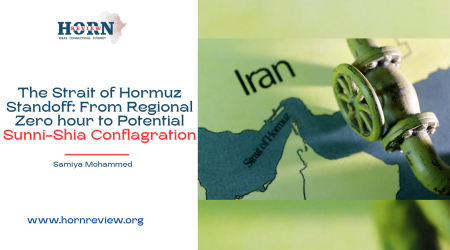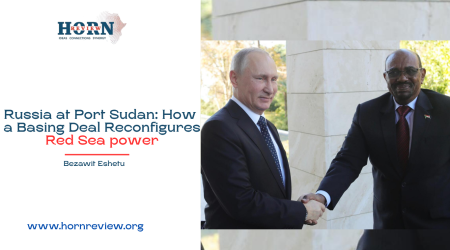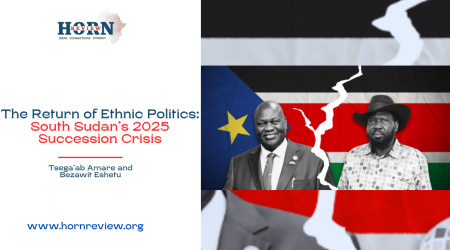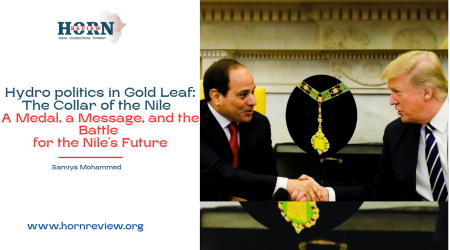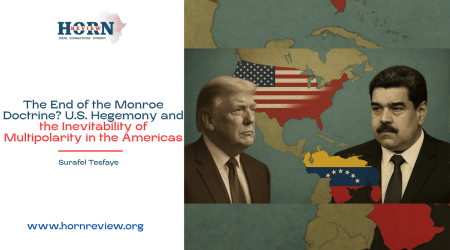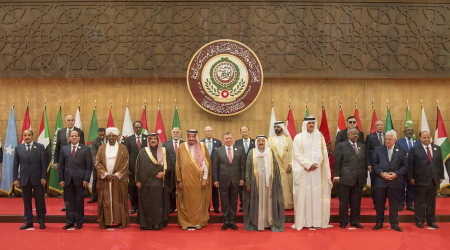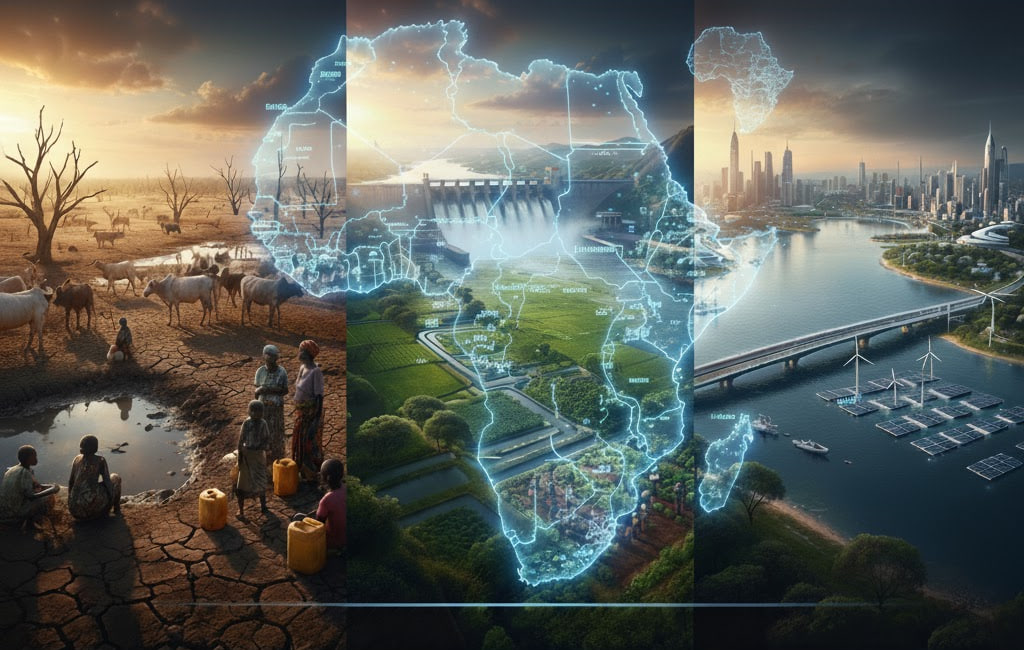
10
Oct
Bridging Inland and Coastal Interests: Securing Africa’s Sovereignty over Strategic Waters through a Pan-African Governance Architecture
Background:
Africa’s waters – both inland and maritime – are among its most strategic assets. Over 90 percent of the continent’s freshwater lies in basins shared by multiple countries (Sadoff, Whittington, and Grey, 2002), making water not only vital but also a critical geopolitical factor. (Gann, 2001) When managed cooperatively, these transboundary rivers, lakes, and maritime zones can serve as catalysts for regional integration. However, without proper coordination, they risk becoming sources of mistrust, power imbalances, and conflict. (Gleick, 1993)
The demand for water across Africa and other parts of the world is growing rapidly. Population growth, urbanization, agricultural expansion, and industrialization are placing intense pressure on already strained water supplies, which are further impacted by climate change. (Henrico and Doboš, 2024) This escalating demand exposes the inadequacies of existing governance frameworks, particularly in vulnerable regions such as Darfur, Lake Chad, and the Sahel, where environmental stress fuels instability.
Water governance in Africa remains fragmented, largely influenced by colonial and apartheid-era policies that prioritized urban centers and extractive industries over rural and indigenous communities. (Kitissou, 2004) These entrenched structural inequities require urgent reform to ensure more inclusive and equitable water management.
Institutional mandates are frequently siloed, resulting in poor coordination between freshwater and marine policies, and between landlocked and coastal states. Infrastructure development, trade facilitation, and environmental protection are often pursued in isolation, despite their interconnected nature. Without a unified Pan-African approach, the continent risks undermining its strategic autonomy and ability to address cross-border water challenges. (African Water Facility, 2023)
Coastal states possess sovereign rights over their territorial waters and Exclusive Economic Zones (EEZs), yet they often lack the capacity to enforce these rights effectively. (UNECE, 2021) This incapacity leaves vast maritime areas vulnerable to illegal fishing, smuggling, and environmental degradation. Meanwhile, landlocked countries – though guaranteed access to the sea under international law – must negotiate costly and politically sensitive transit agreements with coastal neighbors, which can compromise their trade competitiveness and economic sovereignty.
The Strategic Void, and the Risks of Its Exploitation
Africa faces significant challenges in establishing a coherent and effective water governance regime. Central to this struggle is the weak enabling environment prevalent across many countries and river basins. Institutional, legal, and regulatory frameworks are often underdeveloped or inconsistently enforced, hindering integrated and sustainable water resource management.
This issue is exacerbated by deep institutional fragmentation. Overlapping mandates, poor inter-agency coordination, and unclear jurisdictional boundaries at both national and regional levels result in policy inconsistency and delay cooperative initiatives.
Another critical weakness lies in the persistent gaps in data and knowledge. Limited investment in water-related research, monitoring, and knowledge-sharing – especially in transboundary contexts – restricts access to reliable and timely information. This knowledge deficit hampers informed decision-making and opens the door to misperceptions, political manipulation, and inadequate responses to emerging water stresses.
Further complicating the situation is the limited human and technical capacity at subnational, national, and basin-wide levels. Institutions often face challenges such as understaffing, inadequate training, and lack of access to modern technologies essential for effective water resource management.
These vulnerabilities have attracted the attention of external actors, who increasingly view Africa’s water disputes as opportunities for influence. In May 2025, the Arab League issued the Baghdad Declaration, expressing solidarity with Egypt and Sudan in their negotiations with Ethiopia over the Grand Ethiopian Renaissance Dam (GERD). (Aweke, Seid, & Sufiyan, 2025) While largely symbolic, this declaration underscores the geopolitical dimension of African water disputes.
The GERD negotiations have particularly revealed the limitations of Africa’s continental institutions. Ethiopia’s call for “African solutions to African problems” resonates widely; however, the African Union (AU) has largely served as a facilitator and moral guarantor rather than an empowered mediator. Since 2020, the AU has chaired high-level talks, including during South Africa’s presidency, but has lacked the legal authority and political leverage to enforce binding resolutions. While its involvement has helped sustain dialogue, the process highlights the urgent need for stronger continental mechanisms to resolve disputes effectively.
Simultaneously, Africa’s coastal waters are drawing increased foreign military and commercial interest, further complicating the governance landscape (Kitissou, 2004). The European Union’s maritime security programs, along with naval expansions by the United States, China, India, and Russia, have introduced new dynamics. These powers provide training, conduct joint patrols, and invest in port infrastructure. Gulf states such as the UAE, Saudi Arabia, and Qatar have secured long-term port leases and financed logistics hubs along strategic corridors like the Red Sea and Indian Ocean.
While some of these partnerships offer tangible capacity gains, they also highlight a strategic void: the absence of a unified African framework to govern, secure, and leverage the continent’s vast maritime domain. Without such a framework, Africa risks becoming a passive stage for external operations rather than a sovereign actor shaping its maritime future.
Building on What Exists, But Thinking Beyond
Africa is not starting from scratch. Institutions such as the African Ministers’ Council on Water (AMCOW), the 2050 Africa Integrated Maritime Strategy (2050 AIMS), and the Lomé Charter represent important steps toward establishing norms and frameworks for water governance. (African Union, 2012, 2016)
The African Continental Free Trade Area (AfCFTA) also addresses infrastructure, transit, and trade facilitation. However, these frameworks often operate in silos, functioning in parallel rather than in coordination. Moreover, the strategic role of landlocked countries is frequently overlooked in maritime discussions.
Instead of discarding these efforts, Africa must integrate and elevate them within a cohesive Pan-African governance architecture. This architecture should be founded on shared legal principles, aligned investment strategies, and collective security arrangements. It must bridge long-standing divides – between freshwater and marine governance, landlocked and coastal interests, and economic and environmental priorities.
A foundational element of this transformation is comprehensive policy and regulatory reform. National and regional water policies must reflect Integrated Water Resources Management (IWRM) principles. Emphasizing cross-sectoral coordination is essential to bridging gaps between infrastructure, trade, and environmental protection, enabling sustainable and inclusive development across diverse regions. (Ohlsson 1995)
Equally important is institutional capacity building. Strengthening national and subnational institutions, Regional Economic Communities (RECs), and River Basin Organizations (RBOs) to effectively plan and manage water initiatives is critical. Fragile states require targeted support through grant-funded programs that enhance administrative resilience and technical expertise.
Developing robust knowledge and information systems is another essential pillar. Enhancing water knowledge frameworks at regional and basin levels improves governance and strategic planning. Better data accessibility and dissemination support evidence-based decision-making and early warning capabilities. Yet regional disparities in research output persist, with the Global South contributing disproportionately little to global water research.
To address these disparities, Africa must strengthen partnerships with Centers of Excellence, think tanks, international NGOs, and research institutions. Aligning with global initiatives like the Global Water Partnership will amplify impact and foster innovation.
Insights for the Path Ahead
A cooperative and sovereign approach to Africa’s water governance will only succeed if grounded in a few essential insights drawn from both experience and emerging challenges. (Pagett et al., 2021)
First, mutual trust among riparian states is the bedrock of any enduring water-sharing arrangement. Without trust, even the most technically sound agreements risk unraveling. Building that trust requires transparency, consistent dialogue, and a shared recognition that long-term stability benefits all parties.
Flexibility in water use agreements is also vital. Africa’s regions are marked by vastly different geographies, needs, and vulnerabilities. Effective arrangements must be adaptable – capable of adjusting to droughts, demographic shifts, and competing demands – while still upholding principles of equity and fairness.
The strength and legitimacy of River Basin Organizations (RBOs) play a critical role as well. These institutions must be inclusive and empowered, able to coordinate actions across borders and sectors. When structured properly, RBOs can serve as trusted facilitators of dialogue, early warning systems, and platforms for shared investment.
External partners can bring resources, technology, and technical expertise. But their involvement must reinforce, not override, African priorities. Decision-making must remain rooted in local realities, guided by African leadership, and shielded from external agendas that may not align with the continent’s long-term interests.
Finally, history matters. Any governance model must grapple with the colonial legacies, geopolitical dynamics, and structural inequalities that continue to shape water access and usage. Sustainable cooperation demands more than technical fixes; it requires a reckoning with power imbalances and a deliberate effort to rewrite old narratives through new, equitable frameworks.
The Nile Basin offers a striking example of where these insights can drive transformation. By fostering trust, embracing flexible legal tools, strengthening institutions, and maintaining African agency, the region can move beyond zero-sum postures toward genuinely shared prosperity. (Deribe et al., 2024)
Four Pillars for a Pan-African Water Governance Architecture:
To reconcile inland and coastal water interests, Africa needs a governance model that is both technically robust and politically cohesive. The following four pillars outline a strategic foundation for a Pan-African water governance architecture.
- Binding Legal Instruments: Africa must develop a continental legal framework to ensure equitable and sovereign access to shared water resources. A proposed African Union Protocol on Transboundary Water and Maritime Governance could build on existing instruments like UNCLOS and the UN Watercourses Convention. This protocol would institutionalize benefit-sharing mechanisms and formalize transparent, low-cost transit rights for landlocked states. Anchoring legal principles in international conventions and including accessible dispute resolution mechanisms would enhance predictability, trust, and regional authority.
- Institutional Convergence: Africa requires a dedicated continental forum – such as an AU Council for Transboundary Water and Maritime Cooperation – to coordinate governance across sectors and regions. This body would facilitate early warning, dispute prevention, and joint planning, ensuring that upstream interventions and maritime strategies are effectively synchronized.
- Shared Investment Models: Infrastructure should be viewed as a continental public good. AU-backed trust funds and co-investment platforms can finance ports, dams, and transport corridors. Such models reduce dependency on external capital, align development with regional goals, and ensure more equitable returns for all stakeholders.
- Collective Water Security: Water security must be part of Africa’s broader peace and stability agenda. A continent-wide security framework – including joint naval operations, intelligence-sharing, and rapid-response units – would address threats like piracy, illegal fishing, and environmental sabotage. Regional initiatives such as CRESMAC, CRESMAO, and the RMIFC offer a strong foundation. Scaling these efforts through a Pan-African Maritime Security Task Force could replicate effective models like NATO or EUNAVFOR while ensuring alignment with African priorities.
Pathways to Operationalization
Turning the vision of a Pan-African water governance architecture into reality requires a deliberate, phased approach that balances ambition with practicality.
The first step is a comprehensive assessment of knowledge and political will. This involves mapping hydrological systems, evaluating institutional capacities, and analyzing the political economy of water management across different regions. Understanding these realities is crucial for designing governance models that are both responsive and achievable.
Next comes the design and negotiation of governance agreements. (Food and Agriculture Organization of the United Nations n.d.) These agreements should establish fair and flexible water allocation principles, define institutional mandates, and incorporate mechanisms for dispute resolution. Inclusive dialogue with local communities, national governments, basin organizations, and civil society is essential to ensure legitimacy and buy-in.
Once agreements are in place, focus must shift to implementation and accountability. This includes setting up robust compliance systems, monitoring frameworks, and feedback loops to adapt governance mechanisms as conditions evolve. Flexibility is key – particularly as climate change, population growth, and changing consumption patterns reshape water availability and demand.
Allocation mechanisms – whether based on direct quotas, indirect benefits, or shared principles – must be tailored to reflect regional diversity and hydrological variability. They should be adaptable enough to manage periods of scarcity without undermining trust or cooperation. (Just and Netanyahu, 1998)
Effective governance also requires mainstreaming Integrated Water Resources Management (IWRM) and embracing the water-energy-food-ecosystem nexus. This approach promotes cross-sectoral cooperation and helps align water governance with broader development goals. Tools such as Multi-Criteria Decision Analysis (MCDA) and Decision Support Systems (DSS) can guide planning by modeling trade-offs and future scenarios.
However, technical solutions alone are not enough. Strategic leadership and sustained political commitment are vital. Existing high-level summits organized by the African Union (African Union Commission, AMCOW, 2025), either in Addis Ababa or elsewhere, convening ministers of water, defense, infrastructure, and finance – could formally endorse the governance framework and launch key initiatives. Early-stage demonstration projects, especially those linking inland and coastal corridors, would provide tangible proof of concept and generate momentum.
Several countries are already paving the way. Ethiopia’s pursuit of diversified maritime access, Senegal’s Blue Economy Programme, and Namibia’s Blue Economy Policy demonstrate strategic foresight and could serve as pilot models for regional integration.
Ultimately, institutional capacity and human capital must be scaled to support long-term success. The African Union Commission should be equipped with multidisciplinary teams capable of driving implementation. Universities, think tanks, and training centers across the continent must nurture a new generation of experts in water diplomacy, maritime governance, and transboundary cooperation.
Conclusion
A unified water governance architecture is not a luxury – it is a strategic necessity. Water connects Africa’s most pressing challenges: food security, trade, climate resilience, and peacebuilding. If Africa does not assert decisive governance over its waters, others will do it for the continent. This effort demands a fundamental shift from fragmented efforts and external dependency to an African-led, coherent vision that unites inland and maritime governance. It is about transforming vulnerabilities into shared strengths. By embedding cooperation at the heart of sovereignty, Africa can secure a more resilient and self-determined future. In an era of global competition and resource scarcity, Africa must shape its water destiny with intention, strategy, and ambition – before others shape it instead.
By Tsega’ab Amare, Researcher, Horn Review
References
African Union. 2012. 2050 Africa’s Integrated Maritime Strategy (2050 AIMS): A Call for Action. Addis Ababa: African Union Commission. https://au.int/en/documents/30258/2050-aims
African Union. 2016. African Charter on Maritime Security and Safety and Development in Africa (Lomé Charter). Lomé: African Union. https://au.int/en/treaties/charter-maritime-security-and-safety-and-development-africa
African Union Commission, AMCOW, and Government of Zambia. 2025. “3rd Pan-African Implementation and Partnership Conference on Water (PANAFCON-3).“ https://panafricanwater.org/panafcon3.
African Water Facility. 2023. “Water Governance Strategic Pillar.” African Development Bank. https://africanwaterfacility.org/en/our-strategic-pillars/water-governance.
Aweke, A. K., Seid, M., & Sufiyan, S. 2025, May 30. “Re-Arabizing the Nile? The Baghdad Declaration and the Geopolitics of Water Security.” Institute of Foreign Affairs. https://www.ifa.gov.et/2025/05/30/re-arabizing-the-nile-the-baghdad-declaration-and-the-geopolitics-of-water-security/
Deribe, M. M., A. M. Melesse, B. B. Kidanewold, S. Dinar, and E. P. Anderson. 2024. “Assessing International Transboundary Water Management Practices to Extract Contextual Lessons for the Nile River Basin.” Water 16 (14): 1960. https://doi.org/10.3390/w16141960.
Food and Agriculture Organization of the United Nations. n.d. International Watercourses/River Basins Including Law, Negotiation, and Cooperation. https://openknowledge.fao.org/server/api/core/bitstreams/6efdbb52-4b66-408c-91c0-642a94035ad4/content.
Gann, Narottam. 2001. “Water Not Oil.” World Affairs: The Journal of International Issues 5 (3): 94–108.
Gleick, P. H. 1993. “Water and Conflict: Fresh Water Resources and International Security.” International Security 18 (1): 79–112. https://doi.org/10.2307/2539033.
Henrico, I., and B. Doboš. 2024. “Shifting Sands: The Geopolitical Impact of Climate Change on Africa’s Resource Conflicts.” Southern African Geographical Journal: 1–27. https://doi.org/10.1080/03736245.2024.2441116.
Just, Richard, and Sinaia Netanyahu, eds. 1998. Conflict and Cooperation on Transboundary Water Resources. Boston: Kluwer Academic Publishers.
Kitissou, Marcel. 2004. “Hydropolitics and Geopolitics in Africa.” Africa Notes (Cornell University).
Ohlsson, Leif, ed. 1995. Hydropolitics: Conflicts over Water as a Development Constraint. London: Zed Books.
Pagett, R., I. Boateng, K. Appeaning Addo, P.-N. Jayson-Quashigah, and K. Adu-Boahe. 2021. Good Practice for Resilience Planning to Address Water Governance Challenges in Africa. FIG Publication No. 77. International Federation of Surveyors. https://www.fig.net/resources/publications/figpub/pub77/Figpub77.pdf.
Sadoff, Claudia W., Dale Whittington, and David Grey. 2002. Africa’s International Rivers: An Economic Perspective. Washington, DC: The World Bank.
Tafesse, Tesfaye. 2001. The Nile Question: Hydropolitics, Legal Wrangling, Modus Vivendi and Perspectives. Münster: LIT Verlag.
United Nations Economic Commission for Europe (UNECE). 2021. Handbook on Water Allocation in a Transboundary Context (ECE/MP.WAT/64). Geneva: United Nations. ISBN: 978-92-1-117273-7.

